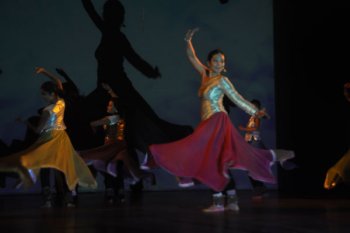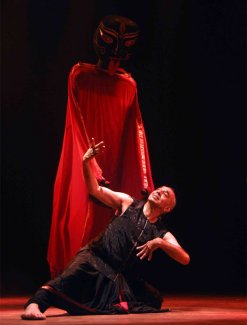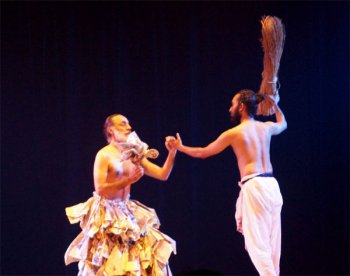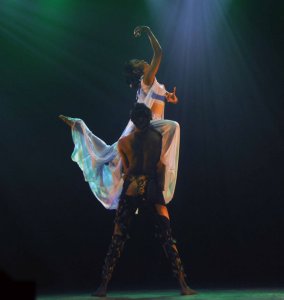
|
 |

|
 |
Questioning Contemporaneity - Veejay Sai e-mail: vs.veejaysai@gmail.com Images courtesy: Arabinda Mahapatra June 25, 2013 No other state has as many cultural festivals like Odisha does. Music, dance, theatre, folklore, tribal, ritual and what have you! Other states in India should surely take a lesson or two in being more inclusive about art and culture when their budgets are made. Contemporary dance has been grappling with its 'Indianness' over the last few decades. Having become an undeniable part of the performing arts world, it is comparable to the English language that has become an integral part of our day to day transactions. Whizzes have termed it everything from 'Modern', 'Neo-classical', 'Progressive' and whatever else. The fact remains, as a creative alternative medium of expression, Indian dance has found its contemporaneity through its individual practitioners, often not backed by any institutional endorsements. "Contemporary dance by Indian dancers is secure in a comfort zone of its own," said Uttara Asha Coorlawala, a veteran in the field, at the brief lecture she delivered at Samakala. Into its second year, the festival organized by the Odisha Sangeet Natak Akademi has already grown into full strength. This year, some of the biggest names from the world of Indian contemporary dance presented their performances in Bhubaneswar. The first evening opened with 'Beautiful Thing 2', a solo by Chennai-based Padmini Chettur. Exploring the ideas of space and one's relation to deconstructing measured mechanics, Padmini's immense control over her body, slow movement, almost driving you to a point of questioning what the actual parameters could be for defining it 'dance' came across. Very European in its sensibilities, hers was a rather slow beginning to the festival. One couldn't help but ask where the dance or the lack of it was in her presentation. Does exhibiting your body control in an excruciatingly slow pace amount to dance? One felt, it was productions like these which keep the doubts on the process intact. If this was one side of the evening, the pendulum of reason swung to the other extreme in the next presentation.  Padmini Chettur  Ashavari Majumdar This was followed by a highly disordered presentation of 'Surpanakha' by Kolkata-based Ashavari Majumdar. While the theme wasn't new by any means, Ashavari's few good ideas got lost in transition. There she was trying to do everything in one package deal. Traditional Kathak, multimedia, flashy costumes, some feminism thrown in, some song and yes, some odd dance; the jigsaw couldn't have gotten more confusing. The show ended up being a kitschy mash of self-indulgence in chaotically strewn sequences. Where does inspiration stop and imitation begin? This was clearly new energy at work, highly out of focus. To add insult to injury, this project was funded by the India Foundation for the Arts. The IFA clearly needs to reconsider towards where its precious resources are directed. At some point in the highly exaggerated presentation Ashavari put up, one couldn't help but wonder if Rama had chopped his own nose off midway. The very foundation and structure of her ideas to put this show together can elevate anyone's exasperation levels. Second day began with a lecture by Uttara Coorlawala at the State Museum. The well-attended talk saw Uttara's journey down her fascinating life as a dancer and choreographer in New York of the seventies. As a student of the legendary Martha Graham, Uttara's ideas of experimenting with the fairly unknown idiom of contemporary dance choreography as an Indian, is a story that deserves a book of its own. It was also wonderful to see how Uttara's thought process grew from her training and learning simultaneously. More such talks and interactions with seasoned practitioners would help enlighten students of dance and general art enthusiasts at large. The evening performances opened with Chennai-based 'contemporary classicist' Anita Ratnam presenting three beautiful excerpts from her earlier works. 'Sita' captured the essence of the unsaid word. Using pure mime to convey the intensity of the words 'me, go, cross, bow, shoulders, no' in her geometry and choreography, one could at least sense an idea in place. The more musical 'Bashonti' took everyone down the nostalgic Tagore lane narrating the poet's romantic fling with Dikshitar's kriti and his visualization of the spring season. Anita's famous 'Neo-Bharatam' style was a delight to watch. In 'Prithvi', her performance crystallized Tagore's powerful words and philosophy with the intense choreography. Here was some progressive content being conveyed through the idiom of dance. Such productions that come with the clear backbone of a narrative structure withhold the sublimity of grace. The concepts of simultaneity and virtuality which are indirect indices of temporality turn out to be fundamental to the understanding of a formal space.  Anita Ratnam  Astad Deboo All art and all creation is the end of a powerful and sustained love pact between the artiste and the material they take to. Combining the dancing and the mimetic gesture to serve as expressions of dramatic action one can say that the 'Indianness' of contemporary dance comes from the need to have a narrative structure. At least for the medium of dance, abstractions seem to work like unconnected dots. A crimson tide enveloped the stage as larger than life puppets with the face of Kali strutted about amidst cheerful applause. In his second production 'Your Grace' based on Tagore's poetry, Astad Deboo created a visual spectacle like never before. The puppets came alive as a part of his touching choreographic narrative. Tagore couldn't have gotten a better visual representation of his poem. This grand gesture created by Astad's choreography flew smooth in its structure and understanding. It was important to notice how each of those puppets eventually found their own center of gravity as a part of the larger scheme in the presentation. While Tagore's poem itself (like most of his) is of a high utopian value and on the margins of constant abstraction, Astad's effort to bring it into form and pair it with the right content won over. Following that was 'Walking Tall,' Astad's version of the famous 'Ekla Cholo re.' In a semi-autobiographical account, Astad reflected on his journey as a dancer who fought against all odds to keep his head high, through decades of his illustrious career. His collaborations with the street kids of the Salam Balak Trust mirrored his efforts to pass on his legacy to the next generation. In Astad's and Anita's work, what stood out was the ability to convey clarity of ideas and the power of recall and retention. These qualities are some of the core values of what the more structured classical forms embody. Bordering on that comfort zone, both these artistes' works and thought processes aligned into various accepted notions of 'Indianness.' The last day of the festival opened with 'Dravya Kaya' by Bharatanatyam dancer Navtej Johar and Sudeep Kumar. Set to a background score of a Ragam and Tanam by Elangovan, the dancers narrated stories of Rama's bow Kodanda and the bark garments Sita had to wear, when banished into the forest. Intermingling techniques of yogic movements and abhinaya, their depiction of Sita adorning her body with bark garments (in this case, a Hula skirt made of crushed newspapers) were highly expressive. All this worked excellent with the physicality of the visuals and friezes Navtej and Sudeep provided through the course of the presentation. However, the underlying philosophy slipped when Navtej decided to conclude with prosaic talk after an intense performance. The character of Sita suddenly gets into a fit of reading poems by Kabir and the like. This not only felt out of place but also became a point of ridicule. Like someone asked, if Sita was sitting depressed in the Ashoka Vatika or did she manage to sneak into the learned Ravana's personal library and lay hands on his poetry books? This anti-climax raised questions on the considerations of contemporary dance. Where does profundity end and triviality begin? At what point can an artiste take the creative licence to dethrone his own value? Some of these questions struck as one observed Navtej's performance end.  Navtej Johar and Sudeep Kumar  Sutra Dance Theatre The grand finale was a group presentation by the dancers of Ramli Ibrahim's Sutra Dance Theatre from Malaysia. While Ramli himself didn't dance, he managed to curate a stunning visual delight with highly enthralling music and choreography. In his brief comment on stage, Ramli announced how the contemporary dance scenario at large needed to still find its own Asian identity and it was time one stopped recycling from the "dustbins of Europe and America." Following that with an idea inspired by Nijinsky, one wondered if the Russian dustbins were worth lifting from. Ramli's attempt at his revisiting Nijinsky's famous 'Afternoon of a Faun' was noteworthy. Making such sweeping statements one needs to be careful as the very idea of 'contemporary' doesn't arrive as a monolith. If not for the various influences that amalgamate, what would the strength of the very idiom be? The degrees of emphasis that contemporary dance practitioners assign to description, interpretation and value judgement is highly subjective and hence relative. All in all, Samakala was a good reason to open up a lot of discussions and debates on the many issues that surround this amorphous creature called 'Contemporary dance.' For long, individual practitioners have been designing their own medium of deliverance. With ample State endorsement and institutional backing, the growing idiom might outlast its imitators.  More pics: Photos by Veejay Sai Veejay Sai is a writer, editor and a culture critic. Post your comments Please provide your name and email id when you use the Anonymous profile in the blog to post a comment. All appropriate comments posted with name & email id in the blog will also be featured in the site. |